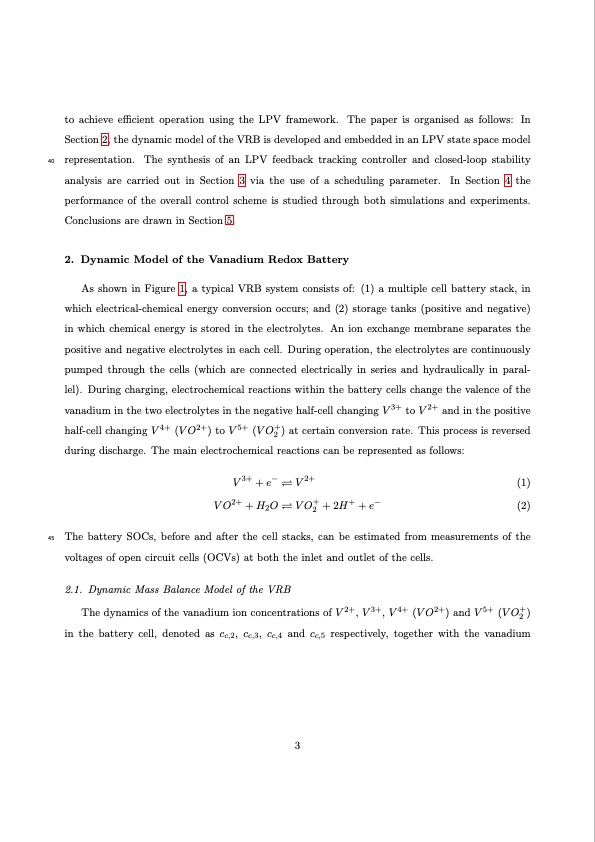
PDF Publication Title:
Text from PDF Page: 003
to achieve efficient operation using the LPV framework. The paper is organised as follows: In Section 2, the dynamic model of the VRB is developed and embedded in an LPV state space model 40 representation. The synthesis of an LPV feedback tracking controller and closed-loop stability analysis are carried out in Section 3 via the use of a scheduling parameter. In Section 4 the performance of the overall control scheme is studied through both simulations and experiments. Conclusions are drawn in Section 5. 2. Dynamic Model of the Vanadium Redox Battery As shown in Figure 1, a typical VRB system consists of: (1) a multiple cell battery stack, in which electrical-chemical energy conversion occurs; and (2) storage tanks (positive and negative) in which chemical energy is stored in the electrolytes. An ion exchange membrane separates the positive and negative electrolytes in each cell. During operation, the electrolytes are continuously pumped through the cells (which are connected electrically in series and hydraulically in paral- lel). During charging, electrochemical reactions within the battery cells change the valence of the vanadium in the two electrolytes in the negative half-cell changing V 3+ to V 2+ and in the positive half-cell changing V 4+ (V O2+) to V 5+ (V O2+) at certain conversion rate. This process is reversed during discharge. The main electrochemical reactions can be represented as follows: V 3+ + e− V 2+ (1) V O2+ + H2O V O2+ + 2H+ + e− (2) 45 The battery SOCs, before and after the cell stacks, can be estimated from measurements of the voltages of open circuit cells (OCVs) at both the inlet and outlet of the cells. 2.1. Dynamic Mass Balance Model of the VRB The dynamics of the vanadium ion concentrations of V 2+, V 3+, V 4+ (V O2+) and V 5+ (V O2+) in the battery cell, denoted as cc,2, cc,3, cc,4 and cc,5 respectively, together with the vanadium 3PDF Image | Electrolyte Flow Rate Control Vanadium Redox Flow Batteries

PDF Search Title:
Electrolyte Flow Rate Control Vanadium Redox Flow BatteriesOriginal File Name Searched:
2201-12812.pdfDIY PDF Search: Google It | Yahoo | Bing
Salgenx Redox Flow Battery Technology: Salt water flow battery technology with low cost and great energy density that can be used for power storage and thermal storage. Let us de-risk your production using our license. Our aqueous flow battery is less cost than Tesla Megapack and available faster. Redox flow battery. No membrane needed like with Vanadium, or Bromine. Salgenx flow battery
| CONTACT TEL: 608-238-6001 Email: greg@salgenx.com | RSS | AMP |